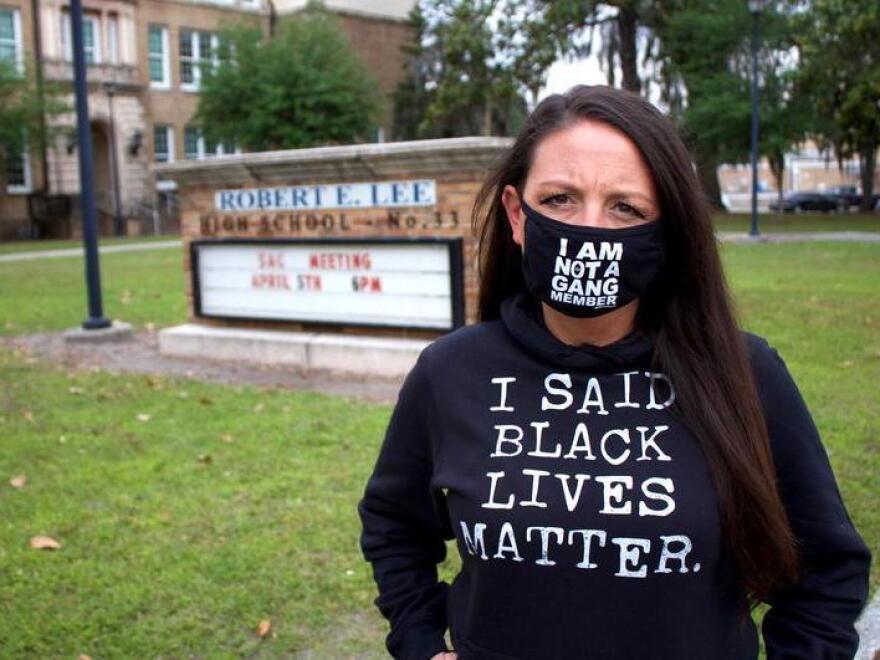Robert E. Lee High School in Jacksonville, Fla., was segregated — whites only — until the 1971-1972 school year. Its school colors are blue and gray, the colors of the Confederacy, and its sports teams are called the Generals.
But a lot has changed since the 1970s: Now, the student body is 70% Black. Students run an Instagram page to document racism they experience at school. And a student group called the EVAC Movement, focused on reframing Black youth in Jacksonville from "at risk" to "at hope," met with then-President Barack Obama in 2016 and presented before the U.S. Office of Juvenile Justice and Delinquency Prevention.
In January 2020, a former member of the EVAC Movement, Reginald Boston, was killed by the Jacksonville Sheriff's Office.
That fall, Amy Donofrio, an English teacher at Lee and co-founder of the EVAC Movement, hung a Black Lives Matter flag outside her classroom to mark it as a safe space for students to process Boston's death.
"His life mattered. Period," Donofrio said. "Walking beside his family, his mom, and seeing what it looks like in real life, there's no possible way that you can't stand by the belief that Black lives matter."
This March, Jacksonville's public school district told Donofrio to take the flag down, saying it violated district policy on political speech by employees.
Donofrio said no. So she was taken out of the classroom and reassigned to non-teaching duties.
Donofrio is now represented by the Southern Poverty Law Center in a lawsuit filed in the U.S. District Court for the Middle District of Florida. The suit alleges the flag's removal was a violation of her First Amendment rights.
Donofrio alleges that the school district consistently undermined the EVAC program by demoting it from a class to a club to an informal group, turning down private funding and blocking her from using non-teaching days to take students on field trips. It felt like the school didn't support its Black students. The conflict over the flag was just the final straw.
"It's a question of whether or not this is a matter of great public significance, whether or not this speech is protected," said Cathleen Scott, a civil rights attorney who is representing Donofrio alongside the Southern Poverty Law Center. "Ms. Donofrio was speaking out against racism. And that's a very important value."
That argument might face an uphill battle in court, said Rachel Arnow-Richman, a professor of labor and employment law at the University of Florida.
"We think of the First Amendment as a foundational principle of our democracy, and it is, but it's subject to many limitations," Arnow-Richman said.
Until recently, the free speech rights of public employees were balanced against the interests of the government as an employer. Courts could consider, on a case-by-case basis, whether a public employee's speech was disruptive to the government's interests in that workplace.
But in 2006, the Supreme Court took the position that when they're on the job, public employees speak for the government, not themselves.
Because of that case, Arnow-Richman said, "public employment is one of the most profound limitations on First Amendment rights."
In her lawsuit, Donofrio is pushing back against that, citing a Florida statute that says school districts may not infringe upon school staff's rights under the Constitution in the absence of written consent.
Arnow-Richman said the law may not have fully wrestled with society's conflicting goals.
"That's to say, this general rule that public employees do not speak for themselves but speak for the government and lack First Amendment protections is at odds, I would say, with our societal interest in wanting teachers to have leeway to communicate and teach students about current issues, bringing to bear their expertise as educators," the professor said.
The school district declined to comment for this story.

For Amiyah Jacobs, a senior at Robert E. Lee High, the Black Lives Matter flag was comforting and she felt the school taking it down was disrespectful. She said she missed seeing Donofrio at school.
"Since we are a Title I school, not everybody has access to the right resources. So she helps out with kids who need hygiene or food or even help applying to college," Jacobs said. "She was just very sweet. And she cared for the students. It wasn't always just about 'Do your work.' "
Jacobs is one of more than 16,000 people who have signed a student-led petition to bring the teacher back to the classroom.
Donofrio said it's stressful to sue her employer, but it also feels like a relief.
"There are educators all over this country that want to stand with our children, that are advocating for our children, and are being retaliated against and pushed back against as a result. And so my goal, my hope, is that by doing this, we can empower more educators to stand beside our kids."
Copyright 2021 WJCT News 89.9


